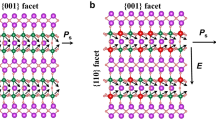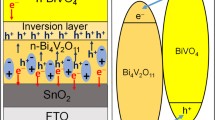Abstract
In this paper, the fabrication of a highly orientated Bi2Fe4O9 (BFO) photoelectrode in the presence of two-dimensional (2D) graphene oxide (GO) was reported. It was found that the GO can be used as a template for controlling the growth of BFO, and the nanoplate composites of BFO/reduced graphene oxide (RGO) with a high orientation can be fabricated. The thickness of the nanoplates became thinner as the ratio of GO increased. As a result, the ferroelectric spontaneous polarization unit arranges itself in the space in a periodic manner, leading to the formation of a polarization field along a special direction. Therefore, the created built-in electric field of the nanoplate composites of BFO/RGO is improved upon the increase of the amount of RGO. As expected, carrier separation is enhanced by the built-in electric field, therefore substantially enhancing the photoelectrochemical (PEC) activity of water splitting compared to pure BFO under the irradiation of visible-light.
Similar content being viewed by others
References
Fujishima A, Honda K. Electrochemical photolysis of water at a semiconductor electrode. Nature, 1972, 238(5358): 37–38
Wang Y, Liu X, Wang X, et al. Metal-organic frameworks based photocatalysts: architecture strategies for efficient solar energy conversion. Chemical Engineering Journal, 2021, 419: 129459
Chen X, Jin F. Photocatalytic reduction of carbon dioxide by titanium oxide-based semiconductors to produce fuels. Frontiers in Energy, 2019, 13(2): 207–220
Chen Y, Wang L, Wang W, et al. Enhanced photoelectrochemical properties of ZnO/ZnSe/CdSe/Cu2 xSe core-shell nanowire arrays fabricated by ion-replacement method. Applied Catalysis B: Environmental, 2017, 209: 110–117
Ding D, Liu K, He S, et al. Ligand-exchange assisted formation of Au/TiO2 Schottky contact for visible-light photocatalysis. Nano Letters, 2014, 14(11): 6731–6736
Ha J W, Ruberu T P A, Han R, et al. Super-resolution mapping of photogenerated electron and hole separation in single metal-semiconductor nanocatalysts. Journal of the American Chemical Society, 2014, 136(4): 1398–1408
Xiao F, Miao J, Tao H, et al. One-dimensional hybrid nanostructures for heterogeneous photocatalysis and photoelectrocatalysis. Small, 2015, 11(18): 2115–2131
Fang W, Zhou J, Liu J, et al. Hierarchical structures of single-crystalline anatase TiO2 nanosheets dominated by {001} facets. Chemistry (Weinheim an der Bergstrasse, Germany), 2011, 17(5): 1423–1427
Yang Z, Wan Y, Xiong G, et al. Facile synthesis of ZnFe2O4/reduced graphene oxide nanohybrids for enhanced microwave absorption properties. Materials Research Bulletin, 2015, 61: 292–297
Maletin M, Moshopoulou E G, Kontos A G, et al. Synthesis and structural characterization of in-doped ZnFe2O4 nanoparticles. Journal of the European Ceramic Society, 2007, 27(13–15): 4391–4394
Yang B, Yuan Y, Sharma P, et al. Tuning the energy level offset between donor and acceptor with ferroelectric dipole layers for increased efficiency in bilayer organic photovoltaic cells. Advanced Materials, 2012, 24(11): 1455–1460
Cui W, Xia Z, Wu S, et al. Controllably interfacing with ferroelectric layer: a strategy for enhancing water oxidation on silicon by surface polarization. ACS Applied Materials & Interfaces, 2015, 7(46): 25601–25607
Paracchino A, Laporte V, Sivula K, et al. Highly active oxide photocathode for photoelectrochemical water reduction. Nature Materials, 2011, 10(6): 456–461
Paracchino A, Mathews N, Hisatomi T, et al. Ultrathin films on copper(I) oxide water splitting photocathodes: a study on performance and stability. Energy & Environmental Science, 2012, 5(9): 8673
Ling Y, Wang G, Reddy J, et al. The influence of oxygen content on the thermal activation of hematite nanowires. Angewandte Chemie International Edition, 2012, 51(17): 4074–4079
Franking R, Li L, Lukowski M A, Meng F, et al. Facile post-growth doping of nanostructured hematite photoanodes for enhanced photoelectrochemical water oxidation. Energy & Environmental Science, 2013, 6(2): 500–512
Klahr B, Gimenez S, Fabregat-Santiago F, et al. Photoelectrochemical and impedance spectroscopic investigation of water oxidation with “co-pi”-coated hematite electrodes. Journal of the American Chemical Society, 2012, 134(40): 16693–16700
Shen R, Ren D, Ding Y, et al. Nanostructured CdS for efficient photocatalytic H2 evolution: a review. Science China Materials, 2020, 63(11): 2153–2188
Liang Z, Shen R, Ng Y H, et al. A review on 2D MoS2 cocatalysts in photocatalytic H2 production. Journal of Materials Science and Technology, 2020, 56: 89–121
Luo W, Yang Z, Li Z, et al. Solar hydrogen generation from seawater with a modified BiVO4 photoanode. Energy & Environmental Science, 2011, 4(10): 4046
McDonald K J, Choi K S. A new electrochemical synthesis route for a BiOI electrode and its conversion to a highly efficient porous BiVO4 photoanode for solar water oxidation. Energy & Environmental Science, 2012, 5(9): 8553
Luo W, Wang J, Zhao X, et al. Formation energy and photoelectrochemical properties of BiVO4 after doping at Bi3+or V5+ sites with higher valence metal ions. Physical Chemistry Chemical Physics, 2013, 15(3): 1006–1013
Chen Z, Zhang N, Xu Y. Synthesis of graphene-ZnO nanorod nanocomposites with improved photoactivity and anti-photocorrosion. CrystEngComm, 2013, 15(15): 3022–3030
Gao F, Chen X, Yin K, et al. Visible-light photocatalytic properties of weak magnetic BiFeO3 nanoparticles. Advanced Materials, 2007, 19(19): 2889–2892
Papadas I T, Subrahmanyam K S, Kanatzidis M G, et al. Templated assembly of BiFeO3 nanocrystals into 3D mesoporous networks for catalytic applications. Nanoscale, 2015, 7(13): 5737–5743
Ruan Q, Zhang W. Tunable morphology of Bi2Fe4O9 crystals for photocatalytic oxidation. Journal of Physical Chemistry C, 2009, 113(10): 4168–4173
Hu Z, Chen B, Lim T T. Single-crystalline Bi2Fe4O9 synthesized by low-temperature co-precipitation: performance as photo- and Fenton catalysts. RSC Advances, 2014, 4(53): 27820–27829
Li Y, Zhang Y, Ye W, et al. Photo-to-current response of Bi2Fe4O9 nanocrystals synthesized through a chemical co-precipitation process. New Journal of Chemistry, 2012, 36(6): 1297
Poghossian A S, Abovian H V, Avakian P B, et al. Bismuth ferrites: new materials for semiconductor gas sensors. Sensors and Actuators. B, Chemical, 1991, 4(3–4): 545–549
Zhang X, Bourgeois L, Yao J, et al. Tuning the morphology of bismuth ferrite nano- and microcrystals: from sheets to fibers. Small, 2007, 3(9): 1523–1528
Zhang X, Lv J, Bourgeois L, et al. Formation and photocatalytic properties of bismuth ferrite submicrocrystals with tunable morphologies. New Journal of Chemistry, 2011, 35(4): 937
Liu M, Lin C, Gu Y, et al. Oxygen reduction contributing to charge transfer during the first discharge of the CeO2-Bi2Fe4O9-Li battery: in situ X-ray diffraction and X-ray absorption near-edge structure investigation. Journal of Physical Chemistry C, 2014, 118(27): 14711–14722
Geim A K. Graphene: status and prospects. Science, 2009, 324(5934): 1530–1534
Li X, Yu J, Wageh S, et al. Graphene in photocatalysis: a review. Small, 2016, 12(48): 6640–6696
Li X, Shen R, Ma S, et al. Graphene-based heterojunction photocatalysts. Applied Surface Science, 2018, 430: 53–107
Wu Y, Luo H, Jiang X, et al. Facile synthesis of magnetic Bi25FeO40/rGO catalyst with efficient photocatalytic performance for phenolic compounds under visible light. RSC Advances, 2015, 5(7): 4905–4908
Zhang Y, Zhu Y, Yu J, et al. Enhanced photocatalytic water disinfection properties of Bi2MoO6-RGO nanocomposites under visible light irradiation. Nanoscale, 2013, 5(14): 6307–6310
Zhou F, Shi R, Zhu Y. Significant enhancement of the visible photocatalytic degradation performances of γ-Bi2MoO6 nanoplate by graphene hybridization. Journal of Molecular Catalysis A Chemical, 2011, 340(1–2): 77–82
Li X, Yu J, Jaroniec M, et al. Cocatalysts for selective photoreduction of CO2 into solar fuels. Chemical Reviews, 2019, 119(6): 3962–4179
Park H S, Kweon K E, Ye H, et al. Factors in the metal doping of BiVO4 for improved photoelectrocatalytic activity as studied by scanning electrochemical microscopy and first-principles density-functional calculation. Journal of Physical Chemistry C, 2011, 115(36): 17870–17879
Acknowledgements
This research was financially supported by the National Natural Science Foundation of China (Grant Nos. 51402314 and 41206067), the Natural Science Foundation of Shandong Province (Grant No. ZR2016BM08), China Postdoctoral Science Foundation (No. 2014M551869), Shandong Excellent Young Scientist Research Award Fund (No. BS2015CL002), and Qingdao Postdoctoral Application Research Fund.
Author information
Authors and Affiliations
Corresponding author
Rights and permissions
About this article
Cite this article
Zhang, Y., Zhu, Y., Peng, Y. et al. Spontaneous polarization enhanced bismuth ferrate photoelectrode: fabrication and boosted photoelectrochemical water splitting property. Front. Energy 15, 781–790 (2021). https://doi.org/10.1007/s11708-021-0782-8
Received:
Accepted:
Published:
Issue Date:
DOI: https://doi.org/10.1007/s11708-021-0782-8




